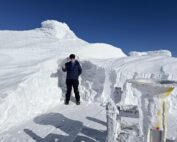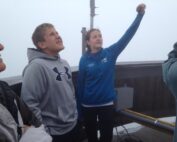The Essential Human Factor
2012-02-01 00:01:21.000 – Rick Giard, Weather Observer / Education Specialist
The Trusty Pitot
We often receive questions about the necessity of maintaining a permanently staffed observatory on Mount Washington. “Why go through the trouble and expense of working, studying and living in one of the world’s most extreme locations?” “Wouldn’t it be easier to just install an automated weather station and obtain the same information?” “And, why do we need meteorologists to forecast the weather? Don’t modern computer models generate accurate and reliable forecasts?”
In fact, the Observatory does have automated installations gathering weather data at six additional elevations of the Auto Road Vertical Profile , providing a valuable vertical temperature and moisture profile. Additional stations of the Mount Washington Regional Mesonet operate at many other key regional locations on and around the higher summits. These provide important supplemental data for improved weather analysis and forecasting. The data from this instrument network is also being collected in large electronic databases for current and future research. However, automated weather stations still require regular maintenance, and in the higher summits environment sometimes malfunction due to extreme conditions. Rime and glaze ice accumulation can be especially problematic, often temporarily interfering with wireless transmission of important data.
To obtain complete and accurate observational data on the summit itself, there is no substitute for the trained and experienced human observer. In the frequent extreme winds and heavy icing, wind and temperature instruments rapidly become inaccurate and eventually cease functioning altogether unless constantly monitored and maintained. Even the unique Pitot Tube Static Anemometer, our most reliable and durable wind instrument, demands constant attention. Moreover, different types of instruments are needed in continually changing conditions. There are also many weather parameters that automated stations simply cannot measure. These include cloud identification at various levels above, below and many miles distant from the station, exact precipitation type and amount, snow depth, and numerous other important atmospheric and optical phenomena.
Finally, although sophisticated, modern computer models can provide valuable guidance to the forecaster, these are by no means completely reliable. Particularly in the complex, varied mountain regions, models simply get it wrong at times. Case in point, yesterday the two most trustworthy models both predicted that the summit would go into the clear with diminishing winds. In fact, for the entire day the summit was in the clouds, with lingering upslope snow showers and winds gusting to hurricane force. An experienced forecaster examines all the factors before issuing the outlook. That is something to ponder when you plan your next higher summits trip.
Rick Giard, Weather Observer / Education Specialist
An Experience Worth 1,000 More
An Experience Worth 1,000 More By Mitchell Tsokatos Me and the summit sign once winter really got going. Taken 11/2/25. Unfortunately, my time on Mount Washington as an intern has come to
Supporter Spotlight: AJ Mastrangelo
Supporter Spotlight: AJ Mastrangelo By Wendy Almeida A young AJ on the summit with Rebecca Scholand. AJ Mastrangelo’s relationship with Mount Washington Observatory began long before his internship—or his current career as
Supporter Spotlight: Angelo Decrisantis
Supporter Spotlight: Angelo Decrisantis By Wendy Almeida For Angelo Decrisantis, Mount Washington has been a lifelong connection. It began in 1965, at age 15, on a family drive to the summit. “My first experience





